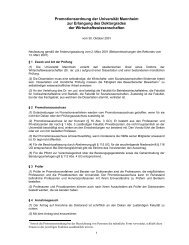The returns to cognitive and non-cognitive abilities in Germany
The returns to cognitive and non-cognitive abilities in Germany
The returns to cognitive and non-cognitive abilities in Germany
You also want an ePaper? Increase the reach of your titles
YUMPU automatically turns print PDFs into web optimized ePapers that Google loves.
<strong>and</strong><br />
u it<br />
is the rema<strong>in</strong><strong>in</strong>g s<strong>to</strong>chastic error term. Us<strong>in</strong>g the HTIV estima<strong>to</strong>r comes with at least<br />
two strong advantages. First, there is no need for model-external <strong>in</strong>struments:<br />
serve as their own <strong>in</strong>struments,<br />
x2,it<br />
x<br />
1,it<br />
<strong>and</strong><br />
is <strong>in</strong>strumented by its deviation from <strong>in</strong>dividual means,<br />
z 1i<br />
x<br />
− x , <strong>and</strong> z is <strong>in</strong>strumented by the <strong>in</strong>dividual average of<br />
2, it 2i<br />
2i<br />
x<br />
1,it<br />
, x<br />
1i<br />
. If the model is<br />
identified, i.e. as long as there are at least as many time-vary<strong>in</strong>g exogenous covariates as<br />
there are time-<strong>in</strong>variant endogenous regressors, the result<strong>in</strong>g FGLS estima<strong>to</strong>r is consistent<br />
<strong>and</strong> efficient (Greene, 2008). <strong>The</strong> second advantage is that, as mentioned, this method allows<br />
estimat<strong>in</strong>g the effects of time-<strong>in</strong>variant covariates that may be correlated with the <strong>in</strong>dividual<br />
specific effects. This is not given <strong>in</strong> our case, s<strong>in</strong>ce we assume that the vec<strong>to</strong>r of the<br />
‘residualized’ personality <strong>and</strong> cognition <strong>in</strong>dica<strong>to</strong>rs is time-<strong>in</strong>variant <strong>and</strong> exogenous. <strong>The</strong> fact<br />
that we do not have time-<strong>in</strong>variant endogenous variables will only affect efficiency but not<br />
consistency of the estima<strong>to</strong>r. Us<strong>in</strong>g the HTIV is still justified because all other covariates are<br />
<strong>to</strong> be treated as endogenous: A Hausman test after additional fixed effects regressions on the<br />
set of time-vary<strong>in</strong>g covariates clearly rejects exogeneity. Year dummies f<strong>in</strong>ally are assumed<br />
<strong>to</strong> be time-vary<strong>in</strong>g <strong>and</strong> exogenous.<br />
Model sensitivity<br />
Sensitivity of the results is exam<strong>in</strong>ed us<strong>in</strong>g a variety of specifications that <strong>in</strong>clude<br />
different sets of socio-economic control variables. First, the basel<strong>in</strong>e specification comprises<br />
a dummy on whether the <strong>in</strong>dividual is liv<strong>in</strong>g <strong>in</strong> East <strong>Germany</strong>, a dummy for be<strong>in</strong>g married, a<br />
dummy for not hav<strong>in</strong>g German citizenship, the <strong>in</strong>dividual’s years of education, <strong>and</strong> a set of<br />
job-related regressors: tenure <strong>and</strong> tenure squared, a dummy on whether the respondent has a<br />
public employer, whether she works <strong>in</strong> a firm with 2000 employees or more, whether she has<br />
18















